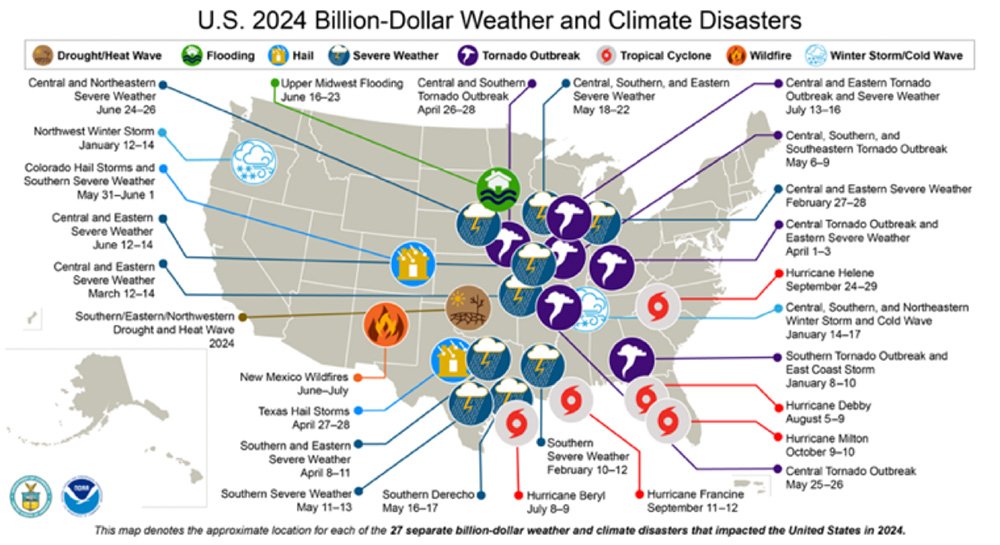by Dr. Dinah Koehler
 Widespread backtracking on climate change mitigation increases risk to businesses. The business impacts of extreme weather are already visible in real-time data, available to businesses today. Wildfire risk now affects one in six Americans, according to First Street Foundation. In 2024, billion-dollar severe weather events were heavily concentrated in the Midwest and along the Gulf Coast, creating widespread business disruption.
Widespread backtracking on climate change mitigation increases risk to businesses. The business impacts of extreme weather are already visible in real-time data, available to businesses today. Wildfire risk now affects one in six Americans, according to First Street Foundation. In 2024, billion-dollar severe weather events were heavily concentrated in the Midwest and along the Gulf Coast, creating widespread business disruption.
At the same time, the stability of the U.S. power grid is being tested. Blackouts have surged by 151% from 2015 to 2021 and are increasingly common during peak summer evenings in the Northeast, South, and Appalachia. Today’s average outage lasts seven hours—dangerously close to the “medically significant” threshold of eight hours.
The data paints a clear picture: business exposure to wildfire, extreme heat, and grid failure is rising. Compound risks are no longer isolated events – they are interconnected, creating cascading disruptions across operations, employees, and revenue streams.
Managing Risk with Location-Specific Climate Intelligence
Waiting is no longer an option for businesses. The good news is that they don’t have to. Companies can proactively manage these evolving threats using real-time, location-specific climate data. By integrating localized risk analytics, such as wildfire exposure, blackout probability, and heatwave trends, businesses can prioritize resilience investments where they are needed most.
Access to granular data enables leaders to map facility, supply chain, and workforce vulnerabilities by region and season. It empowers smarter decision-making: from hardening physical assets against grid instability to adjusting HR policies for extreme heat days. With location-specific climate intelligence, businesses can shift from reactive crisis management to proactive resilience building, safeguarding operations and people in an increasingly volatile environment.
The National Oceanic and Atmospheric Administration (NOAA) maintains detailed, publicly accessible datasets on extreme weather events, tracking the frequency, type, location, and financial impact of major climate and weather events across the United States. Similarly, the U.S. Energy Information Administration (EIA) provides public data on grid reliability, power outages, and energy disruptions by region.
How AI Tools Help
Recent shifts in data access policies and platform usability mean that retrieving, interpreting, and staying current with these resources can be more challenging than in the past. AI-powered tools can dramatically accelerate and deepen the value extracted from these complex datasets. Using natural language processing (NLP), semantic search, and predictive modeling, AI can:
- Automatically identify emerging risks
- Geospatially map exposure by integrating multiple datasets
- Forecast vulnerability by applying machine learning models to historical patterns of outages, storm paths, and financial losses
- Continuously refine insights through iterative queries
- Deliver customized alerts based on a company’s specific facility locations, workforce concentrations, or critical supply chain nodes
Instead of manually sifting through massive spreadsheets and technical reports, AI helps organizations quickly surface actionable intelligence from public data—turning a once-cumbersome task into a strategic advantage.


